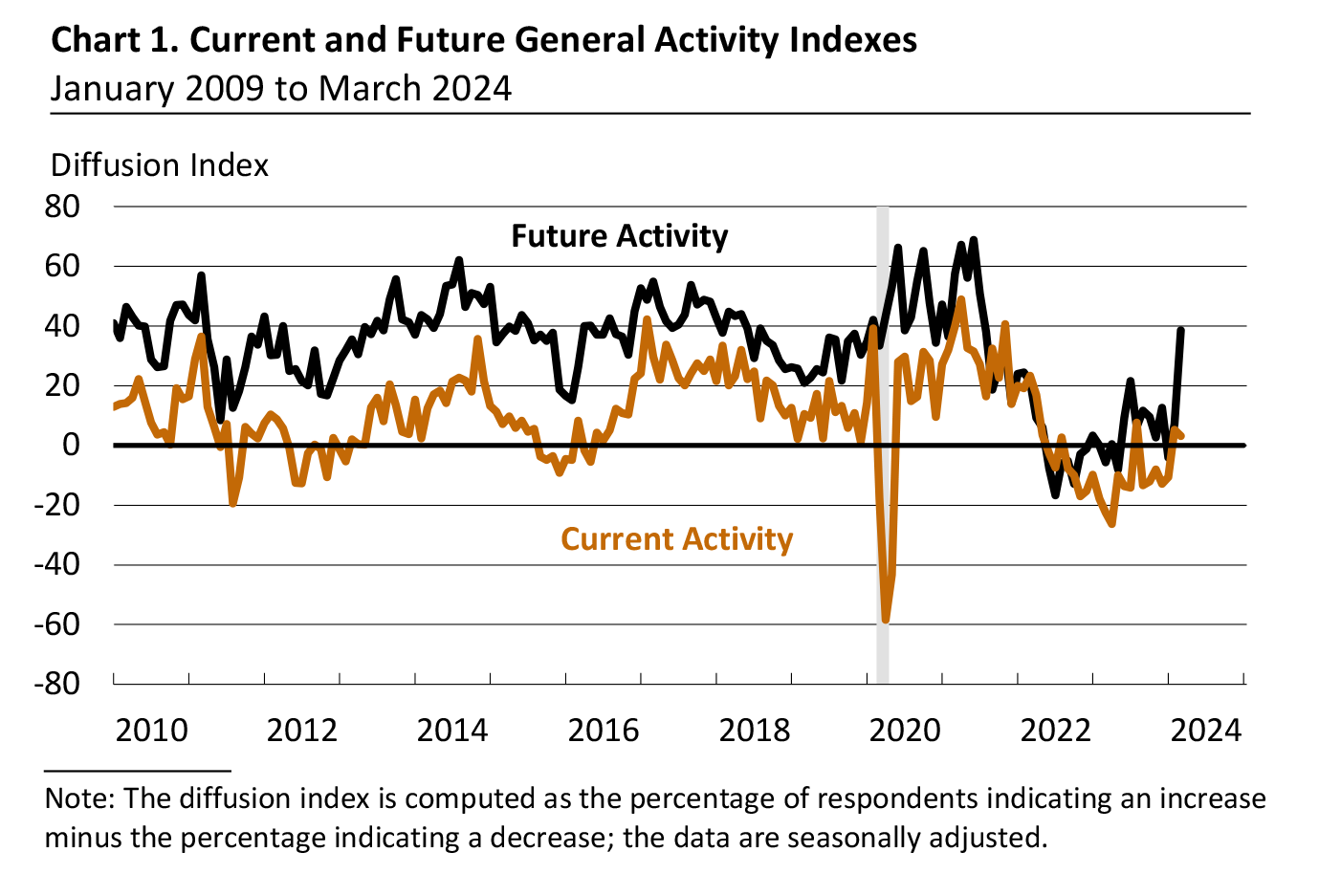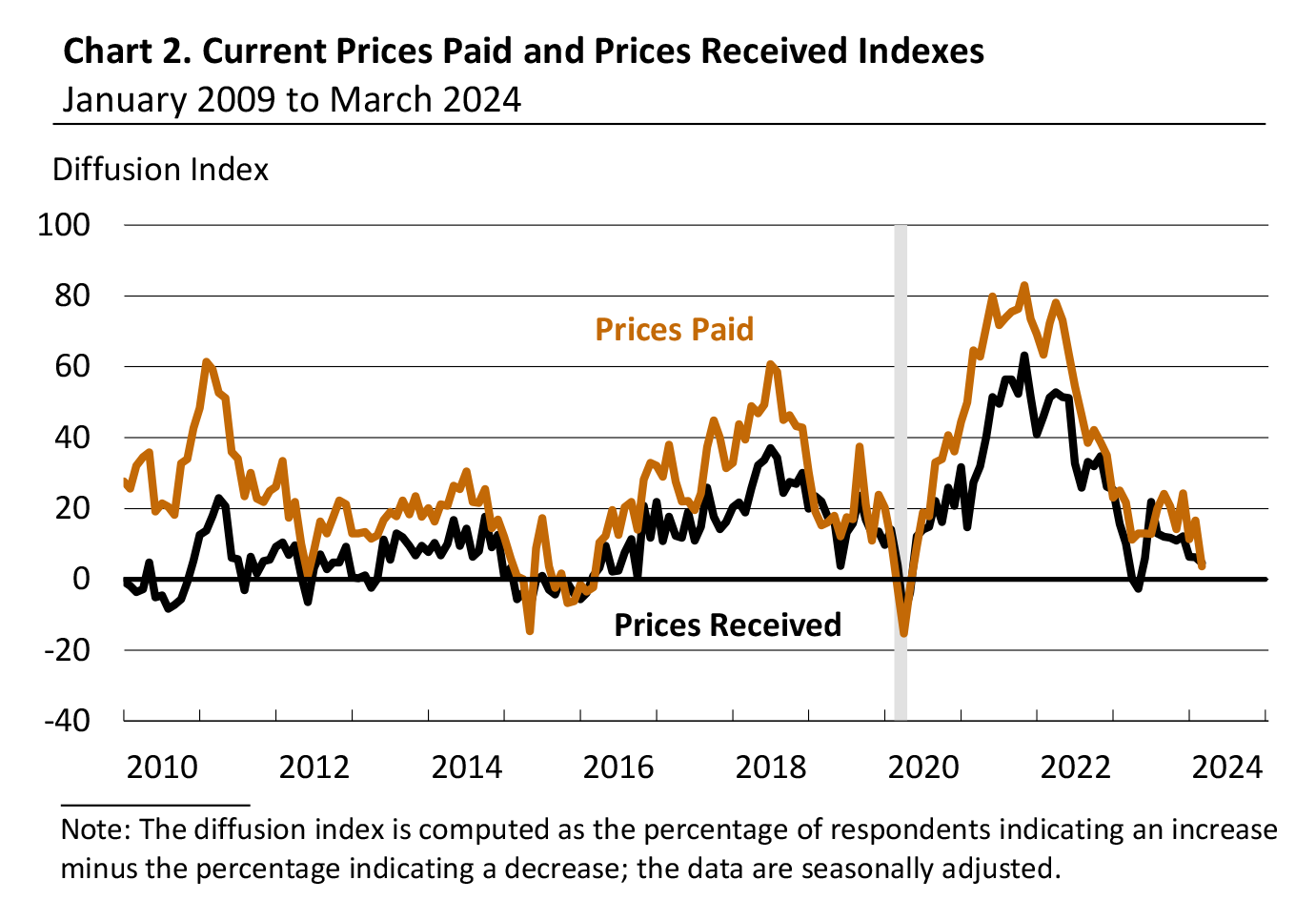March 2024 Manufacturing Business Outlook Survey
Note: Survey responses were collected from March 11 to March 18.
Manufacturing activity in the region continued to expand overall, according to the firms responding to the March Manufacturing Business Outlook Survey. The survey’s indicator for general activity edged lower but remained positive, while the index for shipments ticked up and the index for new orders turned positive. The employment index remained negative, continuing to suggest a decline in overall employment levels. Both price indexes fell and remained below their long-run averages. Future activity indicators rose, suggesting more widespread expectations for overall growth over the next six months.
Current Indicators Remain Below Long-Run Averages
The diffusion index for current general activity edged down 2 points to 3.2 in March, its second consecutive positive reading (see Chart 1). This is only the index’s fifth positive reading since May 2022. Nearly 24 percent of the firms reported increases in general activity this month, while 21 percent reported decreases; 52 percent reported no change. The index for new orders turned positive for the first time since October, rising from -5.2 in February to 5.4 in March. The current shipments index ticked up 1 point to 11.4 in March, its highest reading since August 2022.
On balance, the firms continued to report a decline in employment. The employment index rose 1 point to -9.6 in March, its 11th negative reading in the past 13 months. Most firms (80 percent) continued to report no change in employment, while the share of firms reporting decreases (14 percent) exceeded the share reporting increases (4 percent). The average workweek index fell from 1.4 to -0.2.
Price Indexes Move Lower
Most firms reported no change in prices, and both price indexes remained below their long-run averages; however, on balance, the firms reported overall increases in prices. The prices paid index dropped 13 points to 3.7 in March, its lowest reading since May 2020 (see Chart 2). Almost 14 percent of the firms reported increases in input prices (down from 21 percent last month), while 10 percent reported decreases (up from 4 percent); 75 percent reported no change (up from 70 percent). The current prices received index declined 2 points to 4.6. Nearly 12 percent of the firms reported increases in the prices of their own goods, 7 percent reported decreases, and 81 percent reported no change.
Firms Report Higher Production, Little Change in Capacity Utilization
In this month’s special questions, the firms were asked to estimate their total production growth for the first quarter ending this month compared with the fourth quarter of 2023. A higher share of firms reported an increase in production (41 percent) compared with the share reporting a decrease (27 percent). Regarding firms’ capacity utilization for the current quarter and one year ago, the median current capacity utilization rate reported among the responding firms was unchanged at 70 to 80 percent.
Most firms reported labor supply as at least a slight constraint to capacity utilization in the current quarter, and the share of firms reporting it as a moderate or significant constraint (38 percent) edged up from when this question was asked in December (35 percent). Just over half of the firms reported supply chains were not at all a constraint in the current quarter, a similar share to the previous quarter. Looking ahead over the next three months, most firms expect the impacts of various factors to stay the same. However, the share of firms expecting labor supply impacts to improve (12 percent) was lower than when this question was asked in December (20 percent).
Future Indicators Rise
The diffusion index for future general activity jumped from a reading of 7.2 in February to 38.6 in March, its highest reading since July 2021 (see Chart 1). Half of the firms expect an increase in activity over the next six months, exceeding the 11 percent that expect a decrease; 34 percent expect no change. The future new orders index climbed 26 points to 49.9, and the future shipments index rose 17 points to 43.6. On balance, the firms expect an increase in employment over the next six months, and the future employment index increased from a reading of 4.9 to 5.8. The future prices paid index ticked down to 38.0, while the future prices received index rose 7 points to 37.1. The index for future capital expenditures rose 11 points to 23.6, its highest reading since March 2022.
Summary
Responses to the March Manufacturing Business Outlook Survey suggest an overall increase in regional manufacturing activity this month. The indicator for current activity ticked down but remained positive. The shipments index edged higher, and the new orders index turned positive. On balance, the firms continued to indicate a decline in employment, and the current price indexes suggest overall but less widespread increases in prices. The survey’s broad indicators for future activity strengthened, suggesting more widespread expectations for growth over the next six months.
Special Questions (March 2024)
| An increase of: | % of firms | Subtotals |
|---|---|---|
| 10% or more | 2.9 | % of firms reporting an increase: 41.1 |
| 5-10% | 20.6 | |
| 0-5% | 17.6 | |
| No change | 32.4 | |
| A decline of: | ||
| 0-5% | 5.9 | % of firms reporting a decrease: 26.5 |
| 5-10% | 11.8 | |
| 10% or more | 8.8 |
Capacity Utilization Rate |
2024:Q1 % of Reporters |
2023:Q1 % of Reporters |
|---|---|---|
| Less than 30% | 0.0 | 3.0 |
| 30-40% | 6.1 | 0.0 |
| 40-50% | 0.0 | 6.1 |
| 50-60% | 6.1 | 9.1 |
| 60-70% | 21.2 | 24.2 |
| 70-80% | 33.3 | 24.2 |
| 80-90% | 27.3 | 12.1 |
| 90-100% | 6.1 | 21.2 |
| Median Utilization Rate | 70-80 | 70-80 |
|
Not at all (%) |
Slightly (%) |
Moderately (%) |
Significantly (%) |
|
|---|---|---|---|---|
| COVID-19 mitigation measures | 94.1 | 5.9 | 0.0 | 0.0 |
| Energy markets | 97.1 | 2.9 | 0.0 | 0.0 |
| Financial capital | 88.2 | 5.9 | 5.9 | 0.0 |
| Labor supply | 41.2 | 20.6 | 20.6 | 17.6 |
| Supply chains | 51.5 | 33.3 | 15.2 | 0.0 |
| Other factors | 73.9 | 4.3 | 4.3 | 17.4 |
|
Worsen (%) |
Stay the same (%) |
Improve (%) |
|
|---|---|---|---|
| COVID-19 mitigation measures | 0.0 | 87.9 | 12.1 |
| Energy markets | 3.0 | 97.0 | 0.0 |
| Financial capital | 5.9 | 88.2 | 5.9 |
| Labor supply | 8.8 | 79.4 | 11.8 |
| Supply chains | 0.0 | 91.2 | 8.8 |
| Other factors | 0.0 | 87.5 | 12.5 |
Return to the main page for the Manufacturing Business Outlook Survey.

